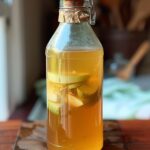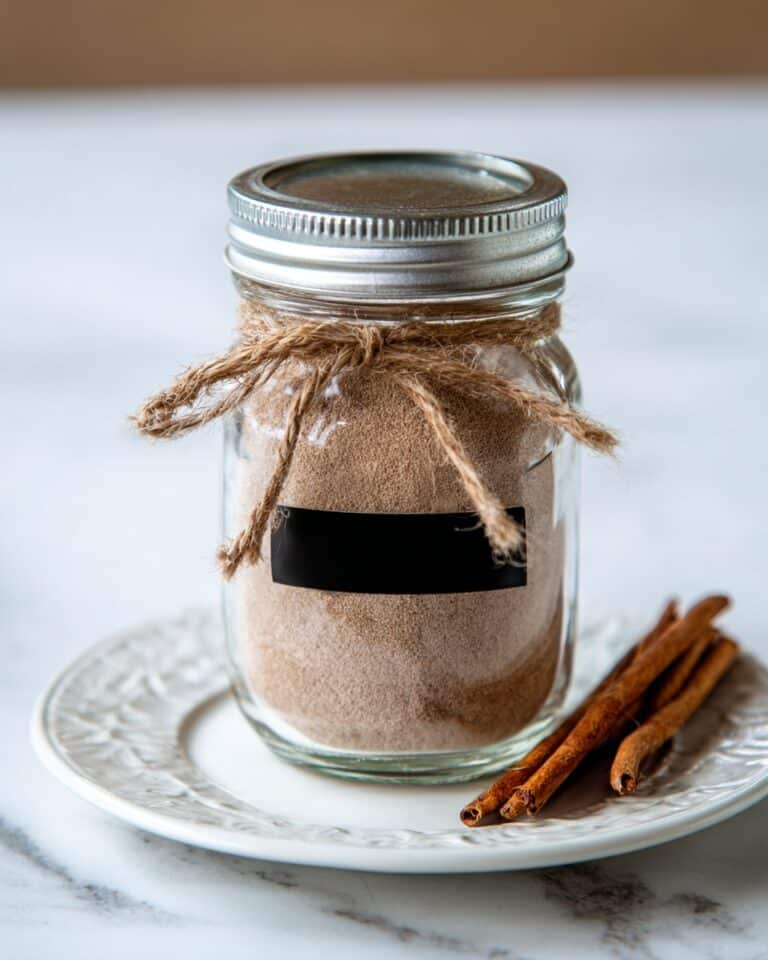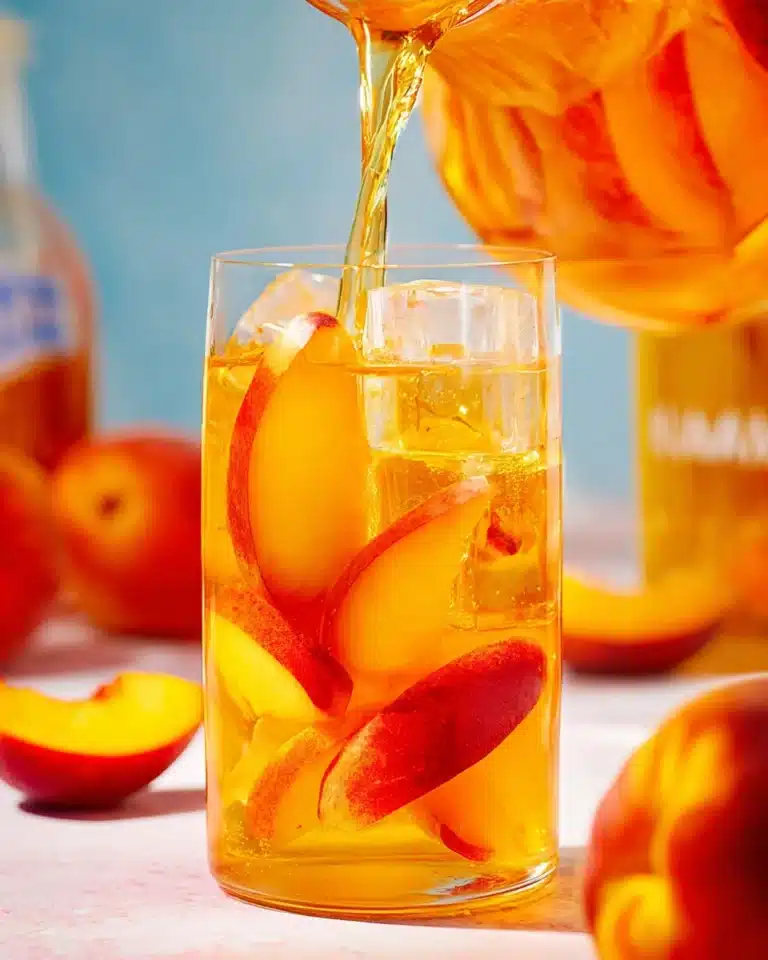Why You’ll Love This Recipe
Making apple cider vinegar from scraps is an excellent way to utilize what would otherwise be discarded, such as apple cores and peels. This method is cost-effective, simple, and yields a product that can be used in various applications, from salad dressings to natural cleaning solutions. Additionally, the fermentation process encourages the growth of the “mother,” a colony of beneficial bacteria that can be used to start future batches.
Ingredients
-
Apple scraps (cores and peels)
-
Filtered water
-
Sugar (1 tablespoon per cup of water)
-
Raw, unfiltered apple cider vinegar (optional, to introduce beneficial bacteria)
(Tip: You’ll find the full list of ingredients and measurements in the recipe card below.)
Directions
-
Place the apple scraps into a clean glass jar, filling it up to about three-quarters full.
-
Dissolve the sugar in warm water and pour it over the apple scraps, ensuring they are fully submerged.
-
Cover the jar with a cloth or coffee filter secured with a rubber band to allow airflow.
-
Store the jar in a warm, dark place for about 2 to 3 weeks, stirring daily.
-
After the initial fermentation period, strain out the solids and return the liquid to the jar.
-
Let the liquid ferment for an additional 2 to 4 weeks, tasting periodically until it reaches the desired acidity.
-
Transfer the finished vinegar into a clean bottle and store it in a cool, dark place.
Servings and Timing
-
Prep Time: Approximately 5 minutes
-
Fermentation Time: 4 to 7 weeks
-
Yield: Varies depending on the amount of apple scraps used
Variations
-
Flavor Enhancements: Add herbs like rosemary or thyme during fermentation for a unique twist.
-
Sweetness Adjustments: Experiment with different sugars, such as honey or maple syrup, to alter the flavor profile.
-
Fruit Combinations: Incorporate scraps from other fruits like pears or peaches for a blended vinegar.
Storage/Reheating
-
Storage: Store the finished apple cider vinegar in a sealed bottle in a cool, dark place.
-
Shelf Life: Properly stored, it can last indefinitely.
-
Reheating: Reheating is generally unnecessary; however, if desired, gently warm the vinegar to enhance its aroma.
FAQs
What types of apple scraps can I use?
You can use cores, peels, and any leftover apple bits. Ensure they are free from mold or rot.
Do I need to use organic apples?
Using organic apples is preferable to avoid pesticides, but non-organic apples can be used if thoroughly washed.
Can I use honey instead of sugar?
Yes, honey can be used, but it may alter the fermentation process and flavor.
How can I tell when the vinegar is ready?
Taste the vinegar periodically; when it reaches the desired acidity, it’s ready for use.
What is the “mother” in apple cider vinegar?
The “mother” is a colony of beneficial bacteria formed during fermentation, indicating a healthy fermentation process.
Can I use store-bought apple cider vinegar as a starter?
Yes, adding a small amount of raw, unfiltered apple cider vinegar can introduce beneficial bacteria to kickstart fermentation.
Why is my vinegar cloudy?
Cloudiness is normal and often indicates the presence of the “mother.”
Can I use apple juice instead of scraps?
Yes, apple juice can be used, but the fermentation process may differ slightly.
Should I refrigerate the vinegar?
Refrigeration is not necessary; store it in a cool, dark place.
Can I reuse the “mother” for future batches?
Yes, the “mother” can be used to inoculate new batches of vinegar.
Conclusion
Making apple cider vinegar from scraps is a sustainable and rewarding practice that allows you to utilize kitchen waste effectively. The process is straightforward, and the resulting vinegar can enhance various aspects of your daily life, from cooking to natural cleaning. Embracing this method not only reduces waste but also connects you to traditional food preservation techniques.
How to Make Apple Cider Vinegar with Scraps
5 Stars 4 Stars 3 Stars 2 Stars 1 Star
No reviews
A simple, eco-friendly method to make homemade apple cider vinegar using leftover apple scraps, promoting sustainability and reducing food waste.
- Author: Paula
- Prep Time: 5 minutes
- Cook Time: 4 to 7 weeks (fermentation time)
- Total Time: 4 to 7 weeks plus 5 minutes prep
- Yield: Varies depending on amount of apple scraps used
- Category: Condiment
- Method: Fermentation
- Cuisine: American
- Diet: Vegan
Ingredients
Apple scraps (cores and peels) – enough to fill about 3/4 of a jar
Filtered water – enough to fully submerge the scraps
Sugar – 1 tablespoon per cup of water
Raw, unfiltered apple cider vinegar (optional) – a small amount to introduce beneficial bacteria
Instructions
- Place the apple scraps into a clean glass jar, filling it up to about three-quarters full.
- Dissolve the sugar in warm filtered water and pour it over the apple scraps, ensuring they are fully submerged.
- Cover the jar with a cloth or coffee filter and secure it with a rubber band to allow airflow.
- Store the jar in a warm, dark place for about 2 to 3 weeks, stirring daily.
- After the initial fermentation, strain out the solids and return the liquid to the jar.
- Let the liquid ferment for an additional 2 to 4 weeks, tasting periodically until it reaches the desired acidity.
- Transfer the finished vinegar into a clean bottle and store it in a cool, dark place.
Notes
- Use only fresh apple scraps free of mold or rot.
- Organic apples are preferable but not required.
- Honey or maple syrup can be used instead of sugar, though fermentation may vary.
- The “mother” is a healthy sign of fermentation and can be saved for future batches.
- Cloudiness in the vinegar is normal and indicates presence of the mother.
- Store vinegar in a sealed container in a cool, dark place; refrigeration is not necessary.
Nutrition
- Serving Size: 1 tablespoon
- Calories: 3
- Sugar: 0.4 g
- Sodium: 0 mg
- Fat: 0 g
- Saturated Fat: 0 g
- Unsaturated Fat: 0 g
- Trans Fat: 0 g
- Carbohydrates: 0.14 g
- Fiber: 0 g
- Protein: 0 g
- Cholesterol: 0 mg









